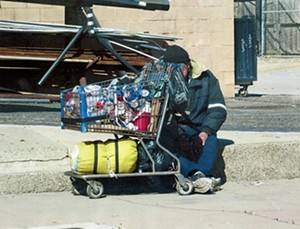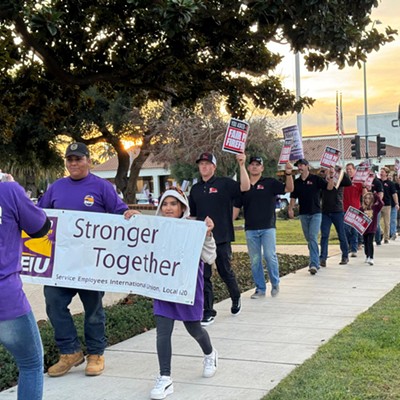There's no silver bullet for solving homelessness and poverty, especially in Santa Barbara County, where roughly 1 in 5 residents live at or near the U.S. federal poverty level. But in a city like Santa Maria, with more than 100,000 residents and high concentration of at-risk populations, the solutions sometimes have to come in the form of small, short-term victories.
For instance, the city annually allocates around $1.2 million in federal community development block grant funds to nonprofits and public service agencies to help feed, shelter, and clothe at-risk and low-income residents.
It's a small piece of the pie in the grand scheme, according to Santa Maria Public Information Officer Mark van de Kamp, but the 18,000 people who benefit from the program signify that the city is at least attempting to address a multifaceted problem.
"I think the key to this is we need to be a partner with our nonprofits," van de Kamp told the Sun.
One of those is United Way of Northern Santa Barbara County, which works with the city to operate its Home for Good coordinated entry system. The program helps families experiencing homelessness connect to resources countywide for their most pressing needs.
"It gives those people tools to lift them up and out of that situation, and in the best case scenario, out of poverty," van de Kamp said.

Santa Barbara County has the third highest poverty rate in California, according to the Public Policy Institute of California. It trails only Los Angeles and Santa Cruz counties.
In 2013, Santa Barbara County officials conducted a report on the region and found the 2007-10 recession resulted in a more than 50 percent increase in residents living below federal poverty thresholds. During that same time, child poverty increased 61 percent.
"Yet, just as the community need for human service programs grew, state and federal budget deficits resulted in deep cuts in human services programs," the report's authors wrote. "These cuts have strained the public and nonprofit safety net infrastructure, leaving Santa Barbara County's most vulnerable community members without adequate resources to make ends meet."
The report identified four cities as high poverty areas: Santa Barbara, Santa Maria, Lompoc, and Isla Vista.
All of the identified cities have relatively high homeless populations, compared to surrounding areas. The 2017 Report on Homelessness in Santa Barbara County found sheltered and unsheltered populations had remained "remarkably consistent in Santa Barbara County over the past six years (1,536 in 2011 vs. 1,489 in 2017)."
The largest increases in counted homeless people were observed in Lompoc, Goleta, and Isla Vista, but Santa Maria still had a fairly large population of homeless (338), or roughly 40 percent more than in 2011 (less than 250).
How the cities handle those populations has varied over the years. Santa Maria has ordinances against "aggressive panhandling" and encourages residents to give their spare change to six special donation meters. The money goes to the Good Samaritan Shelter, the Salvation Army, and the Central Coast Rescue Mission.
Meanwhile, Lompoc police officers will begin evicting a homeless population scattered among 60 to 70 encampments throughout the Santa Ynez Riverbed along the city's north and eastern boundaries in September, after giving people living there a 30-day notice. The Lompoc City Council passed a resolution on Aug. 7 allocating around $20,000 for the effort, but staff documents said the work could end up costing the city hundreds of thousands of dollars. The effort will include collaboration with multiple local nonprofits, Santa Barbara County Mental Health, and Americorps Mission United to set up a "triage center" in River Park until October.
Dinah Lockhart, the deputy director of the Santa Barbara County Housing and Community Development Division, commended the council for "taking some difficult action" that she said would benefit the city in the long term.
"Lompoc is not alone," Lockhart said. "Pretty much every city in the county is dealing with some aspect of homelessness. Probably the beach communities are most impacted because people can just live on the beach, just like they live here on the river bottom."
Lockhart said the Santa Barbara County Board of Supervisors planned to declare a "shelter crisis" in the county at its Sept. 11 meeting to help with funding the removal effort but said that would only encompass unincorporated areas. Cities would have to declare their own crises, she explained, to be eligible for extra funding.
Though the homeless camps residents will be connected with health services like detox centers and shelters, where they'll go remains an unanswered question. Local nonprofits and homeless rights' advocates have pointed to a lack of housing in the area as not only a main factor contributing to homelessness, but to poverty in general.
"Housing plays a central role in the fate of struggling households–not just for their financial stability, but also for their educational prospects and health outcomes," a 2018 study compiled by United Way of California states. "The quality and location of housing for struggling households affects virtually every aspect of their lives, so improvements here can have impact well beyond reducing financial stress."
According to United Way, California's severe shortage of affordable housing would require seven to 10 years of "unprecedented growth in housing–beyond levels that California has seen in its history for even one year." The state ranks 49th nationally for the number of housing units per capita of available rental units for very low-income households and needs an estimated 3.5 million additional housing units to meet existing demand, according to the organization's report.
It's a problem especially prevalent on the Central Coast.
Take Santa Maria, which has attracted major corporate stores at the Enos Ranch Development on Betteravia Road off Highway 101, but has struggles to attract affordable housing developments, van de Kamp explained.
"It's market forces, these developers want to get a return on their investment, but the cost of land continues to increase, and the market is what it's willing to bear ... it's supply and demand," he said.
That's why Santa Maria has guidelines that require a percentage of low and moderate affordable housing to be available, he added.
"But demand is stripping the supply–that's been a constant for many years," van de Kamp said.
The city and its nonprofit partners all say they would like to find a way to attract more affordable housing projects, along with better paying jobs, and with them a higher quality of life for all citizens. But in the meantime, the collaborative partners can only focus on the short-term gains while eyeing the long game.
"It'll be great to have some short-term breakthroughs," van de Kamp said. "We are always looking for that, but also, slow and steady seems to be paying off in some areas."
Staff Writer Spencer Cole can be reached at [email protected].









